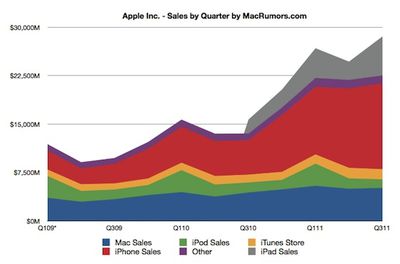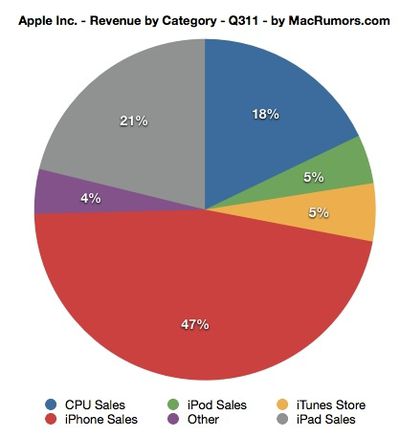Apple today announced financial results for the second calendar quarter and third fiscal quarter of 2011. For the quarter, Apple posted revenue of $28.57 billion and net quarterly profit of $7.31 billion, or $7.79 per diluted share, compared to revenue of $15.7 billion and net quarterly profit of $3.25 billion, or $3.51 per diluted share, in the year-ago quarter. Gross margin was 41.7 percent, compared to 39.1 percent in the year-ago quarter, and international sales accounted for 62 percent of the quarter's revenue. Apple's quarterly profit and revenue were both company records.

Apple shipped 3.95 million Macintosh computers during the quarter, a unit increase of 14 percent over the year-ago quarter. Quarterly iPhone unit sales reached 20.34 million, up 142 percent from the year-ago quarter, and the company also sold 7.54 million iPods during the quarter, representing 20 percent unit decline over the year-ago quarter. Apple also sold 9.25 million iPads during the quarter, up 183 percent over the year-ago quarter.
"We're thrilled to deliver our best quarter ever, with revenue up 82 percent and profits up 125 percent," said Steve Jobs, Apple's CEO. "Right now, we're very focused and excited about bringing iOS 5 and iCloud to our users this fall."
Apple's guidance for the fourth quarter of fiscal 2011 includes expected revenue of $25 billion and earnings per diluted share of $5.50.

Apple will provide live streaming of its Q3 2011 financial results conference call at 2:00 PM Pacific, and MacRumors will update this story with coverage of the conference call highlights.
Conference Call Highlights:
- Highest quarterly revenue and profits. Record iPhone and iPad sales and highest June quarter Mac sales ever.
- Operating margin was a record high.
- 57% year-over-year Mac growth in Pacific segment.
- OS X Lion launching tomorrow
- iPod/iTunes continue to lead market. iTunes revenue up 36% year-over-year.
- Over 225 million accounts, leading music retailer.
- Thrilled to sell record 20.3 million iPhones. 142% growth, more than double IDC's estimate of overall smartphone market.
- Asia Pacific sales almost quadrupled over last year.
- Ended quarter with 5.9 million in channel inventory, up about 700,000 over last quarter.
- 91% of Fortune 500 testing or deploying iPhone; 57% of Global 500.
- iPad sales up 183%, sold every iPad we could make.
- Launched iPad 2 in 36 new countries, now in total of 64 countries.
- 1.05 million iPads in channel inventory, up about 200,000...well below target range.
- Over 222 million cumulative iOS device sales
- In June, we previewed iOS 5 and iCloud. Both launching this fall.
- App Store booming...425,000 apps, 15 billion downloads. $2.5 billion paid out to developers.
- Retail stores: $3.5 billion, up 36% year-over-year. 50% of Mac purchasers new to Mac.
- 327 total stores, with four opened during the quarter
- 73.7 million visitors, up from 60.5 million year-ago quarter.
- 30 new store openings in September quarter, for a total of 40 in fiscal 2011. 28 outside of U.S.
- Cash and marketable securities up $10 billion sequentially to $76.2 billion.
- Now deferring revenue recognition for Lion sales, recognized over period of three years. Same with iCloud. As of June 6th, Apple is deferring $22 of revenue from each Mac sold to be recognized over a period of four years. Also deferring $16 of revenue from each iPhone/iPad and $11 from iPod touch to be recognized over two years.
- Extremely pleased with record revenue and earnings and customer response to our products.
Q&A:
Q: 12% downtick in revenue guidance is more than usual. Why?
A: Let me start with the units. For education buying season, September is weighted toward higher education, and we expect increases there. We also expect increases in iPhone, etc. There is also a future product transition that we are not going to talk about today. Those factors are already in our guidance. Confident in our pipeline. Tim Cook talking about some cannibalization of Mac by iPad. But also cannibalizing Windows. Very happy with 14% growth in Mac.
Q: What about importance of China?
A: We consider greater China to be Mainland China + Hong Kong + Taiwan. Sales 6x year-over-year. This quarter, revenue $3.8b from Greater China. $8.8b over last 3 quarters from Greater China. "We believe this is a substantial opportunity for Apple and we're just scratching the surface."
Q: What about margin predictions?
A: Most components in a very positive pricing situation. HD supply currently constrained but LCD/NAND Flash pricing falling.
Q: Patent disputes, how to put in context with Apple's IP strategy?
A: Tim Cook: "We have a very simple view here. That view is we love competition, we think it's great for us and for everyone, but we want people to invent their own stuff. We're going to make sure we defend our portfolio appropriately."
Q: What drove iPhone strength in the quarter?
A: Tim: We did add 42 new carriers and 15 new countries in the quarter. We continued our expansion efforts to get out beyond the 225 carrier number and above 100 countries. This occurred throughout the quarter and the real sequential improvement was frankly due to emerging and developed markets. China, Latin America driven by Brazil and Mexico was a big part and the Middle East was a big part of it. It's great for Apple because these are markets that Apple historically has not been as strong in, we're really beginning to see the fruits of our labor in these markets.
Q: Milestones hoping to hit over the next quarter for iPhone?
A: It's something that is of great focus to us, we want to do business with great partners and there are great partners for us to do business with. We're always working on new relationships.
Q: Any thoughts in terms of Android activation numbers relative to Apple?
A: Android activation number is a difficult one to get our hands around. Unlike our numbers which we can go to our data sheet and add our iPhone and iPad and make a reasonable approximation of iPod touch, you can quickly see in the June quarter we sold 33 million iOS devices. Across time, we're now over 222 million cumulative iOS devices. We think this is incredible. Our numbers are very straightforward, transparent and reported quarterly.
iPhone is 142% YoY growth. This is 2x the rate of growth of the Smartphone market. We think this is incredible. We sold every iPad 2 in the quarter we could make. There was no shortage of demand. Gaining traction in enterprise. Our intention is not to getting test and pilot programs. We are turning to penetration.
App store is largest by far, if you look at iPad specific apps we're looking at more than 100,000. You'll be hard pressed to find more than a few hundred on other platforms. Other tablets aren't getting any traction to speak of. We've paid $2.5 billion to developers and it's a great business proposition to them. Well over 15 billion apps downloaded, so customers love it too. Confident with products, app store, developers, customer satisfaction ranks iPhone number 1, so confident with customer reception and confident with our roadmap.
Q: Apple TV and connected TV market?
A: Apple TV continues to do well but I don't want to mislead. We still call it a "hobby" and we do that because we don't want anyone to conclude that it's another "leg of the stool" because it's not in the size market that the iPhone, Mac, iPad or iPod is in. We and customers love the product. We really got it right with the new Apple TV but right now it's still a "hobby status". We're continuing to invest in it because we think there's something there.
Q: Diversify contract manufacturing base and non-Apple Retail channel?
A: Tim: Regarding non-Apple retail channel, looking at iPhone for example, we have 115,000 points of sale. Incredibly diversified, selling through carriers, through retail, through our online store, direct sales forces to enterprise -- channel is extremely well diversified. Still countries where we're building the channel, so the journey is not complete. But in mature markets, the channel is in good shape. Not something we're worried about.
Regarding suppliers, we don't want to get into this in any detail. It's part of the magic and part of the things that we have some 'secret sauce' in, and we'd prefer not to share it.
"Are we too centralized in one place?" The people here involved in supply chain always ask that question, I think we always make the right decision for Apple.
Q: How is manufacturing yield on iPhone and iPad coming?
A: Supply of iPad improved through the quarter but we aren't going to comment on specific yield numbers. Further improvements in supply in initial weeks of July and we're in supply demand balance in some countries. Feel very good about progress in that area.
Q: iPhone growth is extraordinary. How can Apple sustain that growth? Approaching saturation -- make changes or keep the business model?
A: Apple doesn't set tariff/plan pricing. At a macro level, if you talk to folks around the world, virtually every carrier desires having more customers with smartphones using data. This is a way for them to expand their ARPUs. We believe there is no better device than the iPhone. The ease of use is unparalleled and we believe there is good alignment in that area.
Key driver in our sequential results in iPhone units are emerging and developing markets. We're putting more energy in these markets that are a big more difficult to do well in than the established countries. We have a very good focus here, we can compete with anyone.
Q: Including prepaid, indirect distribution markets?
A: Looking at emerging markets in the aggregate, most of those are prepaid. We believe postpaid is better in the long term for customer, carrier and Apple. In general we are playing in the prepaid market -- not avoiding that market, we know we need to play there in order to have the types of volumes we'd like to have.
Expanding our channels is obviously on our to-do list.
Q: Mac growth was 5% sequential, notebook sequential was below that. Past few years have been 17-18%. Was this quarter cannibalization? Anticipation of Lion?
A: Tim: Look at YoY than sequential on the Mac. Prouder of the numbers that we achieved -- to grow at 14% when the market is growing at 2.6%, doing 5x the rate of growth, is certainly something to be proud of. Why is the number not higher than 14%? No matter how high it is we would focus on that.
Three things that are the primary factors: First, some cannibalization of new Macs by iPads. Shipped 9.2m iPads during the quarter, 2x the number of Macs shipped. Some customers chose to purchase an iPad instead of a new Mac. But more customers chose to buy an iPad than a Windows PC.
Second, some customers have delayed purchases until Lion becomes available. We are looking forward to getting Lion out. Guys working very hard on it, it's a fantastic product. Revolutionary change.
Third, in the year-ago quarter, we launched new MacBook Pros. In this quarter, we launched new iMacs. Both products were well received, however the MBP makes up the majority of the units that we sell in the Mac segment.
If you change the MBP and its well received, it's going to make the YoY comp more difficult to compare to. Those are the three things impacting Mac growth, but it's already 5x the industry and this is the 21st consecutive quarter that we've beat the market.
Q: What's the growth look like after this quarter for iPads?
A: We don't predict unit sales, we aggregate into guidance. Peter said earlier that we think iPads will grow "significantly" year over year. We'll leave the rest of it to [analysts] to conclude. We'll be happy to report in October how you did.
Q: What are the issues for iPad ramping up production to higher levels? When will we be at equilibrium from production and supply?
A: This is a good sort of problem per se. Demand is fantastic, so there's not something that we would point to on the supply-side that's a huge issue. To talk about this month, the first weeks of July, supply has further improved since we ended our June quarter. That further improvement have led some SKUs in some countries to be in supply/demand balance.
We won't predict on other countries, but we're working very hard to get as many units to customers as we can. We've included that thinking in our guidance.
Q: Anything you're doing different investing in enterprise sales force or going to market on enterprise side?
A: We have a dual prong strategy with enterprise on both iPad and iPhone. We work with carrier sales forces, and they have large ones, many enterprises want devices connected to the carriers. We train and provide help to carriers on that. We do some sales directly or act as an overlay sales force to a channel that sells to enterprise.
Still building it out, and we do a bit better each quarter. Very, very happy with numbers on interest and taking customers to pilot and deployment stages. Now we're working on penetration and getting on the standards lists on those accounts.
To be this far into enterprise with a product that's been shipping for 15 months is incredible. Enterprise is typically much more conservative and takes a long time to evaluate products. People are moving faster than I've seen.
K-12 takes a long time for new product categories but last quarter we sold more iPads in K-12 than we sold Macs. To do that after just 5 quarters is shocking. We would never have predicted this. We feel very good about iPad. It's clear that it has a universal appeal across many different markets: consumer, enterprise, education, government and so on.
Q: How is iCloud going to drive more purchases and a halo effect across other devices?
A: Can't wait to get iCloud and iOS 5 into the hands of customers. We think we've done it right with iCloud -- seamless integrated experience that they're going to love.
Q: Do you have a lead over competitors to instantly mirror content across device?
A: We're very, very good with the Internet, with telecommunications and delivering content. We've proven that for a decade over iTunes, App Store and big developer payments. Probably have things to learn but we have a lot of skills and are excited to get iCloud to customers.
Q: China Mobile has lots of iPhones on its network but it doesn't sell the phone. Sounds like lots of prepaid and unlocked phones on their network. Apple's channel in China is prepaid -- how significant is prepaid in China and other emerging markets? What lessons have you learned?
A: Prepaid or unlocked phones (phones sold without a contract) are very key in China and in a number of emerging markets where the credit systems are not as well established as they are in Western countries.
iPhone volume for the first 3 quarters of the fiscal year was up 5x YoY. iPhone is the key contributor to Greater China having a cumulative revenue of $8.8b for the first 3 quarters. I'm not saying that we have figured out precisely how to play perfectly in the environment -- we haven't. We have more to do and more to learn but I feel very good about our progress there. If any of us had been told a year ago that we'd do $3.8 billion in Greater China in a quarter, we wouldn't have believed it and you wouldn't have believed it.
We're taking our learnings and applying it to other markets as well.
Q: Worldwide market share data is consistent and irrefutable with the iPhone being a share gainer. Market data from a few markets suggests iPhone has lost share. Most of market share data suggests phones over $300 are going to grow much slower than sub-$300. Where do you fit?
A: Share gain is important. Any time we're going the wrong way, we are working hard to change that. Regarding multiple price points, we do offer the 3GS which is $49 with a contract in the US. In prepaid markets, it is affected by the channel and taxes so it varies market-to-market but it's clearly a different price than the iPhone 4 is.
Our philosophy is the same as it always has been. We will only make products that we're proud of and are the best in the world. If we can do that, and the price ends up lower, then we're great with that.
An example of that is the iPod Shuffle. It started at a different price point and now it's $49. It's a great product and a lot of people love it.
We'll only make products we're proud of and we want to know, regardless of price-band analysis. It's up to use to convince people to spend a little more for a materially better product. People will do that if the product is great and the message is appropriate.
Q: What have you learned about media consumption on the iPad?
A: If you talk to 10 people you'll get 10 reasons why they love it. That's why it's doing so well across people and geographies.
Q: Why don't we have more movie titles on iTunes at this point?
A: Broad library of movies and TV shows particularly in the US. Adding more content internationally each quarter. Look for more content later this quarter across the various stores. We have some neat stuff coming.
That's a wrap!























